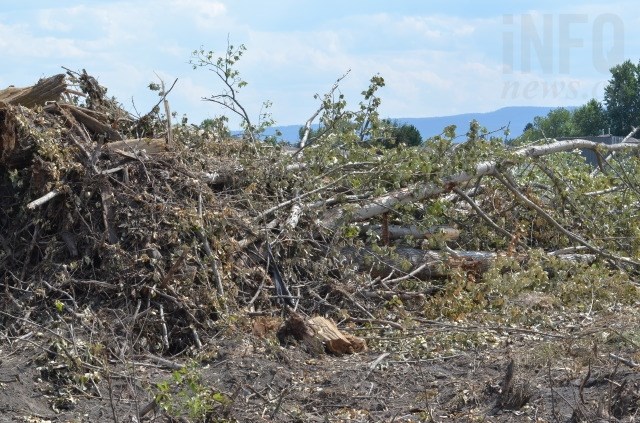
A row of Cottonwood trees were removed in Vernon Aug. 5 and 6 in preparation for a new housing development.
(CHARLOTTE HELSTON / iNFOnews.ca)
August 18, 2015 - 8:00 PM
"WE ALL HAVE PHONES, I'M SURE IF THERE WERE ANY NESTS COMING DOWN PEOPLE WOULD BE TAKING PICTURES OF IT AND RAISING MORE COMPLAINTS": MAYOR
VERNON - The City of Vernon insists an at-risk bird won’t be impacted by recent tree removal work in Vernon because they have no record of them being observed there.
But that’s perhaps because the city has never specifically looked for them — at least not for the last eight years and probably longer.
When the City issued a tree removal permit for a row of Cottonwoods on the lot beside Walmart, it relied on a 2007 forester’s report into the property and information contained in an environmental database to assess whether the at-risk Great Blue Heron was using the trees for habitat. The developer who took out the permit says he was assured by the city that herons were not a concern.
Members of the community, including the owners of a nearby heronry, on the other hand, say the trees were used by herons for resting in and gathering nest-building materials.
Environmental planning and sustainability coordinator Jing Niu remains confident that had herons been there, the city would be aware of it, even without a specific site visit prior to tree removal to review possible environmental impacts.
“My guess is (a 2007 forester’s report) would have picked it up,” Niu says. “My guess is also that the environmental planner of the day would have picked it up at the time as well.”
The November 2007 report makes no mention of any wildlife using the trees for habitat, and focusses primarily on the public safety hazard posed by falling tree limbs. The environmental database the city relied on was last updated in 2013. It identifies areas around Vernon as either low, medium or high in terms of environmental sensitivity. That information is obtained through a mixture of GIS (Geographic Information System) and select ground visits. There's no record anyone from the city ever visited in person, yet the city remains satisfied any sign of herons nesting there would have been picked up.
“In this particular case it didn’t come up as one of the areas flagged so we can only assume there was nothing significant there,” Niu says.
The developer was also warned to adhere to any provincial or federal regulations — like the Species at Risk Act, Migratory Bird Act, and Canadian Environmental Assessment Act — but the city has no ability to enforce those laws because it's outside their jurisdiction, Niu says.
“It’s up to them (developer) to ensure they’re following all legislation, but we give them that reminder and make sure they get that extra warning to make sure they’re doing things right at every level,” Niu says.
To the city’s knowledge, there were no federal or provincial regulations that would have applied to the property or tree removal, Niu says.
Vernon Mayor Akbal Mund admits there would be benefits to a personal site visit, but says he has not seen or heard anything to suggest there were ever herons using the site.
“There were lots of people there I’m sure (when the trees were cut down)… We all have phones, I’m sure if there were any nests coming down people would be taking pictures of it and raising more complaints,” Mund says. “Everyone’s speculating there were, but there’s no proof there was, no photos. You have to look at the facts.”
And while photos of nests coming down during tree removal may have confirmed the herons were there — albeit too late to do anything about it — Mund maintains nothing prior to the permit being issued ever suggested herons were there.
He says other trees were removed in the area over the years as businesses like Walmart were developed, and points out the herons continue to return and nest in a protected area nearby.
“There were a lot of other trees removed that didn’t seem to affect the population back then,” Mund says.
But Mariko McDougall, the education coordinator at the Allan Brooks Nature Centre in Vernon, says any habitat removal in the area around the rookery could have adverse impacts — even if the trees weren’t specifically used for nesting.
“I would suspect they (herons) were using the trees for perching, resting and gathering of nesting supplies,” McDougall says. “It’s all part of their habitat; it would be akin to saying humans need their house to survive, therefore the neighbourhood doesn’t matter at all.”
As human development encroaches on the protected nesting area, the birds could be affected, she says, and adds historical development might even have left the birds more reliant on the now-removed trees.
“The whole Walmart area used to be prime heron habitat,” McDougall says.
Heron habitat is typically made up of wetland areas and certain trees, like the Cottonwoods that were chopped down.
“If they continue to lose habitat, they would decrease in numbers for sure. I would say habitat loss is threatening them,” McDougall says.
To contact the reporter for this story, email Charlotte Helston at chelston@infonews.ca or call 250-309-5230. To contact the editor, email mjones@infonews.ca or call 250-718-2724.
News from © iNFOnews, 2015